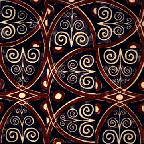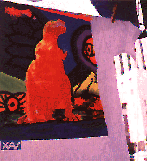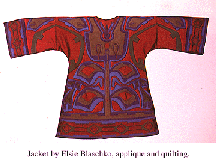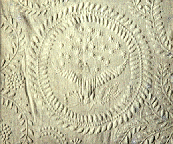

Dye: Colorant that chemically bonds with the fibers
Pigment: Colorant that adheres to the surface of the fibers
Painting: Application of a colorant to the surface of a cloth in a non-repetitious manner by means of a brush, sponges, or other instrument.
Printing: Application of a colorant to the surface of a cloth to create a repeatable design by means of a prepared surface which is pressed against the cloth.
| Block printing | 
|
and silk screen | 
|
are common methods of hand printing textiles. |
Resist: Any process by which areas of the cloth are protected from the action of dyes.
 Applique:
The technique of stitching cut shapes of fabric onto a background fabric.
Applique:
The technique of stitching cut shapes of fabric onto a background fabric.
Embroidery: the decorative application of threads to the surface of a
textile by means of a needle.
 Patchwork:
Pieces of fabric, usually in different colors and patterns, assembled to create
a larger panel.
Patchwork:
Pieces of fabric, usually in different colors and patterns, assembled to create
a larger panel.
 Quilting:
Stitching which holds layers of fabric and (usually) an inner layer of padding
together. (Note: quilts need not involve patchwork, and patchwork need not be
quilted!)
Quilting:
Stitching which holds layers of fabric and (usually) an inner layer of padding
together. (Note: quilts need not involve patchwork, and patchwork need not be
quilted!)

|